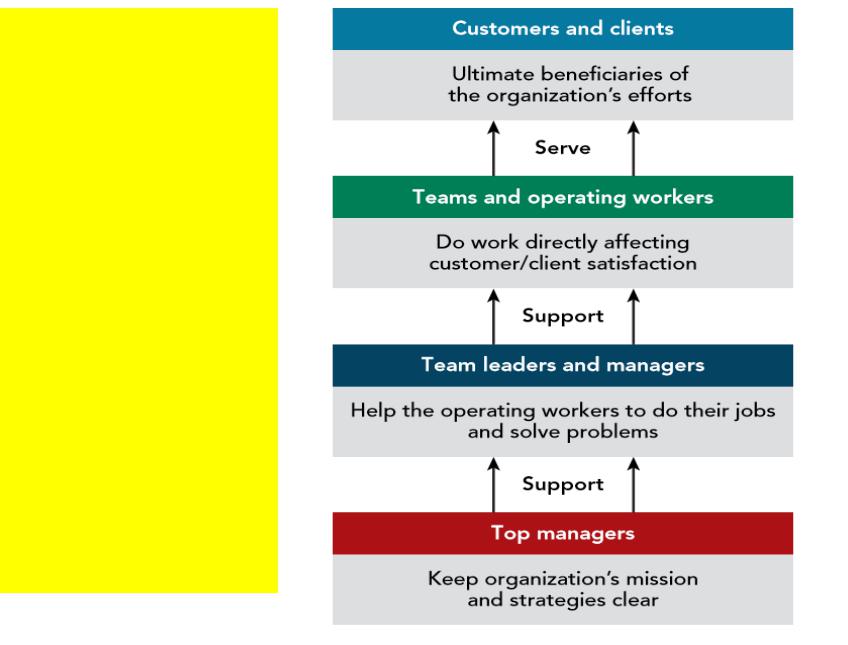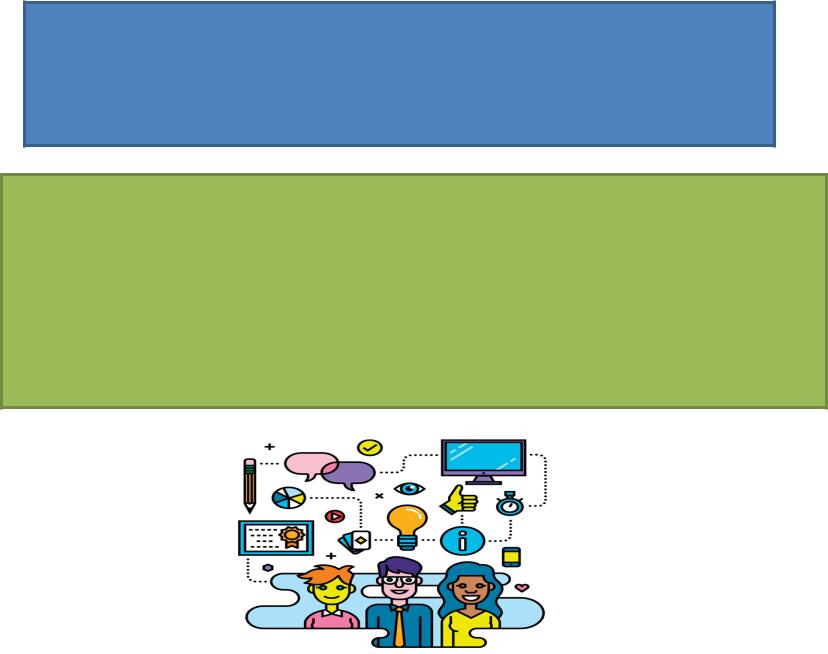
- ••Management
- •Topic 1.
- •Organization
- •“Management is the process of designing and maintaining an environment in which individuals
- •Definition
- •Importance of Management
- •Contd.
- •What do Managers Do? The Management Process
- •MANAGERS
- ••first-line managers include department head, team leader, and unit manager. For example, the
- ••Job titles such as chief executive officer (CEO), chief operating officer (COO), chief
- •A chief executive officer (CEO) is the highest-ranking executive in a company, whose
- •In both business and the public sector, board members are supposed to oversee
- •Accountability Is a Foundation of Managerial Performance. The term accountability describes the requirement
- •Effective Managers Help Others Achieve High Performance and Satisfaction. An effective manager helps
- •Are you willing to work anywhere other than in a high-QWL setting? Would
- •Managers Are Coaches, Coordinators, and Supporters. We live and work in a time
- •If we turn the traditional organizational pyramid upside down, we get a valuable
- •Terms to Define: Accountability Board of directors Effective manager First- line managers
- •Questions for Discussion 1. Other than at work, in what situations do you
- •What Do Managers Do, and What Skills?
- •Topic 2. The Five Functions of Management by Fayol's
- •What Four Functions Make Up the Management Process? Contemporary theory
- •The management process is planning, organizing, leading, and controlling the use of resources
- •Organizing is the process of assigning tasks, allocating resources, and coordinating work activities.
- •Organizing. Even the best plans will fail without strong implementation. Success begins with
- •Leading .The management function of leading is the process of arousing people’s enthusiasm
- •Controlling is the process of measuring work performance, comparing results to objectives, and
- •Managers Perform Informational,
- •Agenda Setting Agendas are important in management, and it is through agenda setting
- •Managers engage in networking to build and maintain positive relationships with other people,
- •A technical skill is the ability to use a special proficiency or expertise
- •The ability to work well with others is a human skill, and a
- •Conceptual Skill The ability to think critically and analytically is a conceptual skill.
- •Conceptual skills are important for all managers but gain in relative importance as
- •Lifelong learning is continuous learning from daily experiences. Learning agility is the
- •Rapid Review • The daily work of managers is often intense and stressful,
- •Globalization is the worldwide interdependence of resource flows, product markets, and business competition.
- •Failures of Ethics and Corporate Governance are Troublesome.
- •Workforce diversity describes differences among workers in gender, race, age, ethnicity, religion, sexual
- •personal career readiness—the combination of skills, competencies, aspirations, and goals that can move
- •Rapid Review • Globalization has brought increased use of global outsourcing by businesses
- •Intellectual capital is the collective brainpower or shared knowledge of a workforce.
- •Taylor’s scientific management sought efficiency in job performance. • Weber’s bureaucratic organization is
- •Taylor noticed that many workers did their jobs in their own ways—perhaps haphazardly
- •Taylor’s approach to scientific management can be summarized in these four core principles
- •The scalar chain principle states that organizations should operate with clear and unbroken
- •Rapid Review • Taylor’s principles of scientific management focused on the need to
- ••Follett viewed organizations as communities of cooperative action.
- •Follett suggested that making every employee an owner in the business would create
- •The Hawthorne Studies Focused Attention on the Human Side of Organizations.
- •Maslow Described a Hierarchy of Human Needs with Self-Actualization at the Top. The
- •Maslow’s progression principle is that a need at any level becomes activated only
- •Maslow’s work, along with the Hawthorne studies, surely influenced another prominent management theorist,
- •Theory X assumes people dislike work, lack ambition, are irresponsible, and prefer to
- •Argyris Suggests That Workers Treated As Adults Will Be More Productive. Ideas set
- •Argyris clearly believes that when problems such as employee absenteeism, turnover, apathy, alienation,
- •Rapid Review • Follett’s ideas on groups, human cooperation, and organizations that served
- •• Managers use quantitative analysis and tools to solve complex problems. • Organizations
- •In our world of vast computing power and the easy collection and storage
- •Analytics is the systematic use and analysis of data to solve problems and
- •Problem: A big box retailer is trying to deal with pressures on profit
- •Operations management is the study of how organizations produce goods and services.
- •An open system transforms resource inputs from the environment into product outputs.
- •Contingency thinking tries to match management practices with situational demands.
- •Quality Management Focuses
- •Any research following the scientific method will display the following characteristics:
- •Rapid Review • Advanced quantitative techniques in decision sciences and operations management help
- •Learn About Yourself
- •Ethics and Social Responsibility
- •• Ethical behavior is values driven. • Views diff er on what constitutes
- •Consider this situation. About 10% of an MBA class at Duke University were
- •Terminal values focus on desired ends or what someone wants to achieve, such
- •Views Differ on What Constitutes Moral Behavior
- •Utilitarian View A business owner decides to cut 30% of a small firm’s
- •Justice View A behavior is ethical under the justice view of moral reasoning
- •Interactional justice focuses on treating everyone with dignity and respect. For example, does
- •The moral rights view considers behavior to be ethical when it respects and
- •Cultural relativism suggests there is no one right way to behave; cultural context
- •Ethical imperialism is an attempt to impose one’s ethical standards on other cultures.
- •I define an unethical situation as one in which I have to do
- •People Have a Tendency to Rationalize Unethical Behavior.
- •“It’s not really illegal.” Wrong—this implies that the behavior is acceptable even in
- •Ethical frameworks are wellthought-out personal rules and strategies for ethical decision making.
- •Rapid Review • Ethical behavior is that which is accepted as “good” or
- •An immoral manager chooses to behave unethically. An amoral manager fails to consider
- •Ethics training seeks to help people understand the ethical aspects of decision making
- •Discrimination—“Factories shall employ workers on the basis of their ability to do the
- •Rapid Review • Ethical behavior is influenced by an individual’s character and represented
- •The way organizations behave in relationship with their many stakeholders is a good
- •Perspectives Differ on the Importance of Corporate Social Responsibility.
- •Shared value approaches business decisions with understanding that economic gains and social progress
- •Rapid Review • Corporate social responsibility is the obligation of an organization to
- •Concepts of Leader and Manager
- •Comparison bet. Leadership and Management
- •Comparison bet. Administration & Management
- •Administration Versus Management
- •Contd.
- •Productivity Orientation
- •Human Relation Orientation
- •Process Orientation
- •Decision-Making Orientation
- •Contd.
- •Systems Approach
- •Contd.
- •System approach
- •Function of Management
- •Planning
- •Contd.
- •Contd.
- •Contd.
- •Organizing
- •Organizing involves:
- •Contd.
- •Leading
- •Contd.
- •Controlling
- •Principles of management that will apply in different situations
- •“Management by Objectives”
- •Contd.
- •“Division of Labor”
- •Contd.
- •“Coordination of Activities” or “Convergence of work”
- •“Substitute of Resources”
- •“Functions Determine Structure”
- •“Delegation of Authority”
- •Contd.
- •Contd.
- •“Management by Exception”
- •General Principles of Management-
- •Division of work: This is the specialization that economists consider necessary for efficiency
- ••Subordination of individual to general interest: This is self explanatory when the two
- •Initiative: Initiative is conceived of as the thinking out and execution of a
- •The Environment
- •Decision making/Problem Solving Steps
- •Six Criteria to Systematically Evaluate Ideas
- •The Overall Planning Process
- •Strategic Goals
- •How Goals Facilitate Performance
- •Plans According to Extent of Recurring Use
- •The Strategic Management Process
- •The functional structure of organization
- •Matrix organisation structure
- •Tall organisational structure with seven
- •Flat organisation with three(3) levels
- •Methods of Horizontal Co-ordination
- •Horizontal coordination methods for increasing information-processing capacity
- •Formal and informal groups in an organisation
- •The Control Process
- •Steps in the control process
- •Four levers of strategic control
- •Thank You

If we turn the traditional organizational pyramid upside down, we get a valuable look at how managerial work is viewed today. Managers are at the bottom of the upside- down pyramid, and they are expected to support the operating workers above them. Their goal is to help these workers to best serve the organization’s customers at the top. The appropriate mind-set of this supportive manager is more “coaching” and “helping” than “directing” and “order giving.”

Terms to Define: Accountability Board of directors Effective manager First- line managers
Governance Manager Middle managers Quality of work life Top managers Upside-down pyramid
Rapid Review • Managers support and facilitate the work efforts of other people in organizations. • Top managers scan the environment and pursue long-term goals; middle managers coordinate activities among large departments or divisions; and first-line managers, such as team leaders, supervise and support nonmanagerial workers. • Everyone in an organization is accountable to a higher-level manager for his or her performance accomplishments; at the highest level, top managers are held accountable by boards of directors or boards of trustees. • Effective managers help others to achieve both high performance and high levels of job satisfaction. • New directions in managerial work emphasize “coaching” and “supporting,” rather than “directing” and “order giving.” • In the upside-down pyramid view of organizations, the role of managers is to support nonmanagerial workers who serve the needs of customers at the top.

Questions for Discussion 1. Other than at work, in what situations do you expect to be a manager during your lifetime? 2. Why should a manager be concerned about the quality of work life in an organization? 3. In what ways does the upside-down pyramid view of organizations off advantages over the traditional view of the top-down pyramid?

What Do Managers Do, and What Skills?
Managers plan, organize, lead, and control. •Managers perform informational, interpersonal, and decisional roles. •Managers use networking and social capital to pursue action agendas. • Managers use technical, human, and conceptual skills. • Managers should learn from experience.

Topic 2. The Five Functions of Management by Fayol's
•The Five Functions of Management was the most important of Fayol's six industrial activities (technical, commercial, financial, security, accounting, managerial) and included.
•Planning - examining the future and drawing up plans of actions
•Organizing - building up the structure (labour and material) of the undertaking
•Commanding - maintaining activity among the personnel
•Coordinating - unifying and harmonizing activities and efforts
•Controlling - seeing that everything occurs in conformity with policies and practices
•Fayol carried the management process beyond the basic hierarchical model developed by Taylor. Under Fayol’s system, the command function continued to operate efficiently and effectively through a series of co-ordination and control methods. He recommended regular meetings of department heads and liaison officers to improve co-ordination of organizational operations. He presented his thinking in his work to serve as a model for the educational program he espoused. His work was largely ignored in the U.S. until it was republished in 1949.
•

What Four Functions Make Up the Management Process? Contemporary theory

The management process is planning, organizing, leading, and controlling the use of resources to accomplish performance goals.
Planning In management, planning is the process of setting performance objectives and determining what actions should be taken to accomplish them. When managers plan, they set goals and objectives and select ways to achieve them.

Organizing is the process of assigning tasks, allocating resources, and coordinating work activities.
Leading is the process of arousing people’s enthusiasm and inspiring their efforts to achieve goals.
Controlling is the process of measuring performance and taking action to ensure desired results.

Organizing. Even the best plans will fail without strong implementation. Success begins with organizing, the process of assigning tasks, allocating resources, and coordinating the activities of individuals and groups. When managers organize, they bring people and resources together to put plans into action. Example: At Ernst & Young, Laskawy organized to meet his planning objective by convening and personally chairing a Diversity Task Force of partners. He also established a new Office of Retention and hired Deborah K. Holmes, now Americas Director of Corporate Responsibility, to head it. As retention problems were identified in various parts of the firm, Holmes created special task forces to tackle them and recommend location-specific solutions.

Leading .The management function of leading is the process of arousing people’s enthusiasm to work hard and inspiring their efforts to fulfill plans and accomplish objectives. This is one of the most talked about managerial responsibilities, and it deserves a lot of personal thought. Not every manager is a good leader, but every great manager is one for sure. Holmes actively pursued her leadership responsibilities at Ernst & Young. She noticed that, in addition to the intense work at the firm, women often faced more stress because their spouses also worked. She became a champion of improved work–life balance and pursued it relentlessly. She started “call- free holidays,” where professionals did not check voice mail or e-mail on weekends and holidays. She also started a “travel sanity” program that limited staffers’ travel to four days a week so they could get home for weekends. And she started a Woman’s Access Program to provide mentoring and career development.
